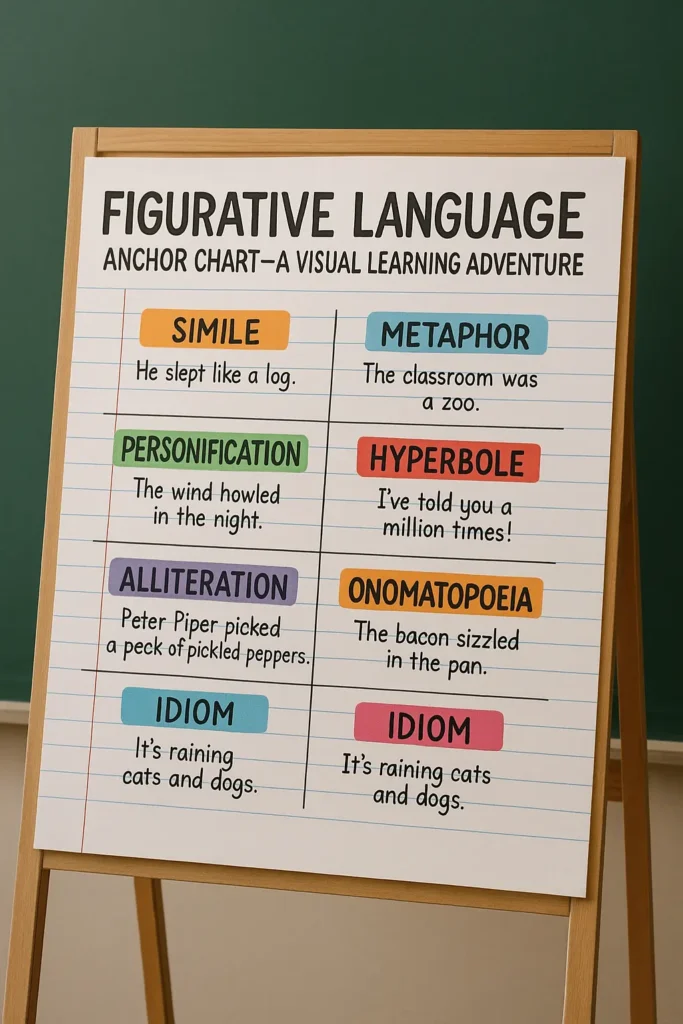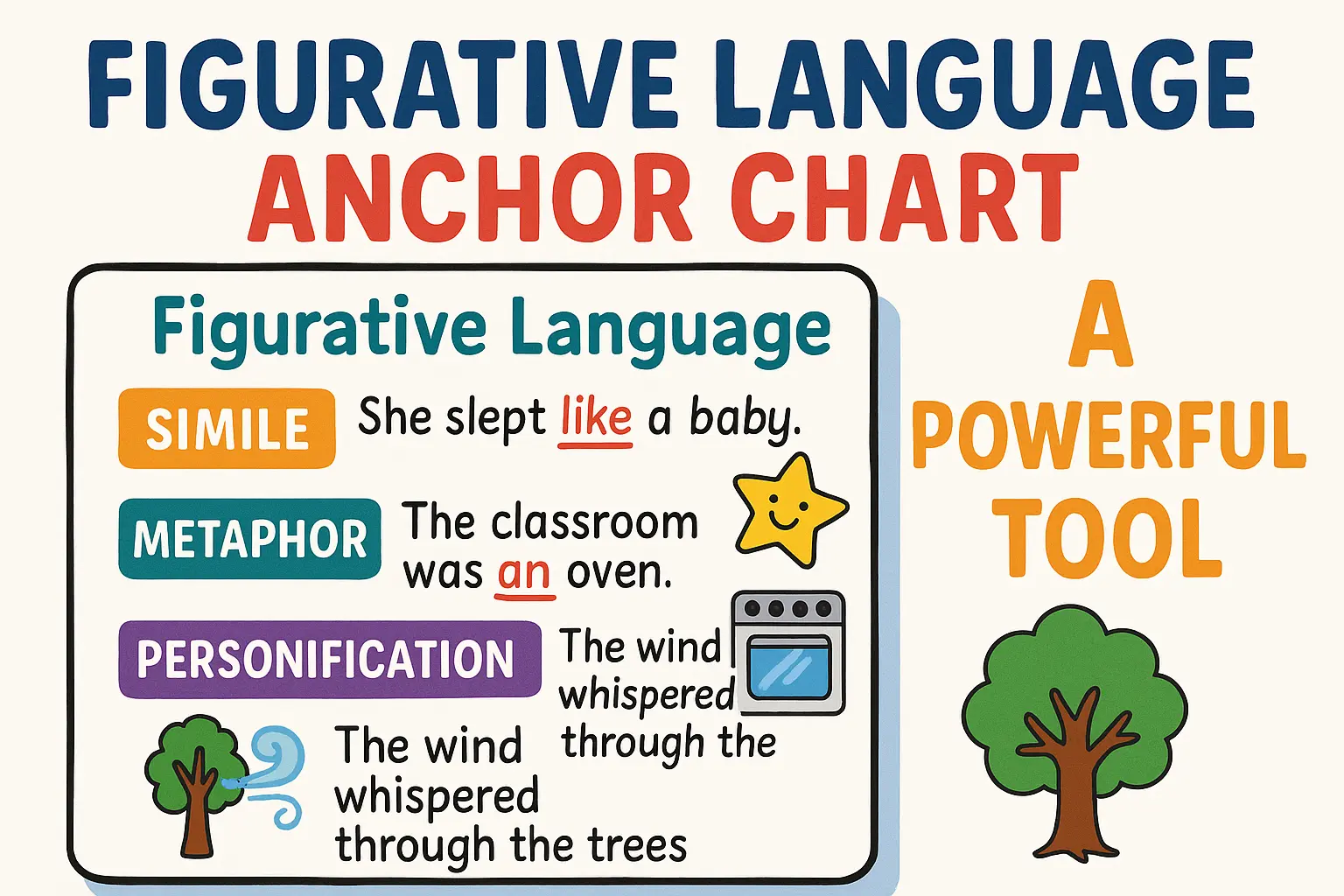Figurative Language Anchor Chart is a powerful tool for enhancing student learning in a fun and engaging way. In this article, we’ll explore how visual aids can make figurative language concepts like metaphors, similes, and personification easier to understand. You’ll learn how to create a Figurative Language Anchor Chart that not only simplifies these concepts but also captures the attention of students, helping them grasp these essential skills with ease. Whether you’re an educator or a student, this guide offers practical tips for mastering figurative language.
Figurative language plays a crucial role in literature and communication. It enhances the richness of language, making it more expressive and engaging. By using techniques like metaphors, similes, and personification, writers can convey deeper meanings and emotions. Understanding figurative language helps readers connect more profoundly with texts and improves their overall comprehension skills.
Anchor charts are a powerful tool for visual learning. These charts act as a reference guide, helping students grasp complex concepts more easily. They serve as a visual reminder that students can refer to during lessons, making learning interactive and engaging.
When figurative language is combined with anchor charts, it becomes even more effective. The visual representation of abstract concepts allows learners to better understand and remember the material. This method is not only beneficial for younger students but also aids learners of all ages in retaining the knowledge and applying it in real-life situations. Anchor charts make figurative language fun, accessible, and memorable for everyone.
What is Figurative Language?
Figurative language is a technique used in writing to make it more engaging, vivid, and expressive. By using comparisons and exaggerations, writers can add depth and emotion to their work. Figurative language helps readers connect with the text on a deeper level, making the reading experience more enjoyable and memorable. Common examples of figurative language include metaphors, similes, personification, and hyperbole.
Why Use an Anchor Chart for Figurative Language?
Anchor charts are valuable tools for teaching figurative language because they support visual learning, which helps simplify complex concepts. Visual aids like anchor charts allow students to see figurative language examples and their meanings in one place, making it easier to understand and remember. By incorporating colorful visuals, clear definitions, and examples, anchor charts transform abstract ideas into something more tangible for learners.
Anchor charts also encourage interactive and collaborative learning. They can be displayed in the classroom, allowing students to engage with the material throughout lessons. Teachers can prompt students to contribute their own examples or modify the chart, making it a dynamic resource. This interaction fosters deeper understanding and keeps students engaged.
Incorporating anchor charts into lessons helps students grasp figurative language more effectively. They promote active participation, simplify difficult ideas, and serve as a go-to reference tool, making learning both fun and productive for all ages.
Elements of a Figurative Language Anchor Chart

- Clear Headings and Definitions: Include concise, easy-to-understand definitions for each type of figurative language, such as metaphors, similes, and hyperboles. This ensures students know exactly what each term means.
- Colorful Visuals and Examples: Use vibrant images or drawings that correspond with each type of figurative language, along with simple examples. This helps students visualize the concepts and remember them more easily.
- Interactive Elements: Add quizzes, fill-in-the-blank exercises, or spaces for students to contribute their own examples. This makes the anchor chart more engaging and encourages active learning.
- Real-Life Examples: Use relatable, real-world examples of figurative language, such as quotes from popular movies or books. This makes abstract concepts feel more accessible to students.
Steps to Create Your Own Figurative Language Anchor Chart
Creating a figurative language anchor chart is an engaging and effective way to help students understand these concepts. Here’s a step-by-step guide to get started:
- Choose the Types of Figurative Language: Decide which figurative language elements to include, such as metaphors, similes, personification, and hyperbole.
- Provide Clear Definitions and Short Examples: Write simple definitions for each type, followed by a short, relatable example to help clarify the concept.
- Use Visuals: Add relevant images or drawings that visually represent each figurative language element, making the concepts easier to grasp.
- Make It Interactive: Include space for students to add their own examples or participate in quick exercises to reinforce learning.
- Display in the Classroom: Put the anchor chart up in a visible location so students can refer to it during lessons, encouraging frequent use and engagement.
Creative Ideas for Enhancing the Chart
To make a figurative language anchor chart more engaging, creative ideas can be used to boost its visual appeal and interactivity.
- Use of Symbols, Images, and Colors: Incorporating symbols, colorful images, and varied colors helps break down complex concepts and makes the chart more visually stimulating. Bright visuals attract attention and make it easier for students to remember.
- Incorporating Fun and Familiar Themes: By adding pop culture references, like quotes from popular movies or books, students will feel more connected to the material. This makes learning fun and relatable.
- Encouraging Students to Create Their Own Anchor Charts: Allowing students to participate in creating or personalizing the chart as a learning activity helps reinforce their understanding. This collaborative approach encourages ownership and deeper learning.
How to Use the Anchor Chart in the Classroom
Using a figurative language anchor chart effectively in the classroom can enhance learning and engagement. Here are some tips for teachers:
- Integrate the Chart into Daily Lessons: Refer to the anchor chart during lessons to reinforce the concepts. Use it as a visual guide when explaining figurative language, making the learning process more interactive.
- Encourage Students to Refer to the Chart: Encourage students to consult the chart during assignments or discussions. This helps them apply figurative language in their own work and boosts confidence.
- Use the Chart for Group Activities and Creative Writing: The anchor chart can be a great starting point for group activities, games, or creative writing exercises. It allows students to experiment with figurative language in a fun and collaborative way.
Real-Life Application of Figurative Language
Figurative language plays a key role in real-world communication, enhancing how people express emotions and ideas. In advertising, for example, brands use metaphors and similes to make their messages more memorable. Storytelling is also enriched with figurative language, adding depth and creativity to narratives. Public speaking often relies on personification and hyperbole to captivate audiences and make speeches more impactful.
Also Check: Basic Comma Rules
Famous examples include Nike’s “Just Do It” campaign, which uses a powerful call to action, and the quote “Time is money,” a metaphor widely used in business. These examples show how figurative language can effectively engage audiences and convey complex ideas in a simple, impactful way.
Conclusion
In conclusion, a figurative language anchor chart is a valuable tool for enhancing students’ understanding of figurative language. By providing clear definitions, examples, and visuals, it simplifies complex concepts and makes learning more interactive. This approach encourages deeper engagement, helping students connect with the material in a fun and accessible way.
Also Check: Occasion Wish Generator

